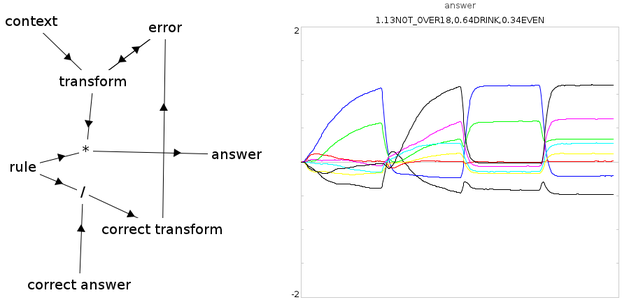Two experimental conditions show that the model can learn to process rules differently depending on context, and that it can generalize to new rules within a context.
The Wason selection task presents participants with a set of 4 cards and a rule. Given the rule, participants must choose which cards to flip over to confirm whether or not the rule is being followed. The standard result is that people will process a rule in very different ways, depending on context. For example, with cards showing "A", "B", "2", and "3" and the rule "If a vowel is on one side of the card, then the other side must be an even number", most people choose to flip over the cards "A" and "2". The logically correct choice is to select "A" and "3". However, if the cards show "age:16", "age:22", "drink:water", and "drink:beer", while the rule is "If under 18, then you must drink water" most people correctly choose "age:16" and "drink:water". Of course, these two conditions are logically identical.
Our model of this task indicates how this process might be learned. There are four inputs to the model: the current rule, the current context, the answer to learn in this context, and a signal to turn learning on or off. The output is the choice of which cards to examine.
All values are represented as randomly chosen Semantic Pointers:
high-dimensional vectors that can be compressed together to store
structured information. For example, the rule "If an even number is on
one side of the card, then the other side must be a vowel" is
represented by the vector ANTE*VOWEL+CONS*EVEN, where ANTE
(antecedent), VOWEL, CONS (consequent) and EVEN are randomly
chosen 128-dimensional unit vectors and * is circular
convolution. The answer given by most people would then be
VOWEL+EVEN.
The standard explanation of the observed effect is to assume that people have learned different ways of processing rules in different contexts. In the "social" context, people have practiced following rules of this form (perhaps as part of cheater-detection). However, when presented with what is logically the same rule in an abstract context, people fall back on a different strategy of simply focusing attention on the two things that have been highlighted in the rule itself.
To give a mechanistic account of this process, we need to demonstrate two things. First, that the model can learn to process the rule in different ways in different contexts. Second, that the rule processing can generalize within a context. These are shown by taking the same model and providing it two different sets of inputs, called experiment 1 and experiment 2.
For experiment 1, we simply present a single example of the two different contexts and turn learning on. Then we turn learning off and confirm that it has learned the correct transformation. In particular, the inputs are as follows:
context=-1,rule=ANTE*VOWEL+CONS*EVEN,answer=VOWEL+EVEN, learning on for 1.5scontext=1,rule=ANTE*DRINK+CONS*OVER18,answer=DRINK+NOT*OVER18, learning on for 1.5scontext=-1,rule=ANTE*VOWEL+CONS*EVEN, learning off for 1.5scontext=1,rule=ANTE*DRINK+CONS*OVER18, learning off for 1.5s
The expected result is that in block 3 the model will answer
VOWEL+EVEN while in block 4 it will answer DRINK+NOT*OVER18.
Experiment 1 merely demonstrates that it can learn specific examples in specific contexts. However, the whole point of such a system is to be able to process novel rules in a context-appropriate manner. This is shown in experiment 2.
context=1,rule=ANTE*DRINK+CONS*OVER21,answer=DRINK+NOT*OVER21, learning on for 1.5scontext=1,rule=ANTE*VOTE+CONS*OVER18,answer=VOTE+NOT*OVER18, learning on for 1.5scontext=1,rule=ANTE*DRIVE+CONS*OVER16, learning off for 1.5s
In block 3, the model correctly generalizes and answers
DRIVE+NOT*OVER16. Importantly, it does this without ever having seen
that input previously.
See the publication for more details
- Start Nengo 1.4
- Run
wason.pyscript - Go to interactive plots and press play
- To change to experiment 2, change the line
experiment=1toexperiment=2at the top of the script.
